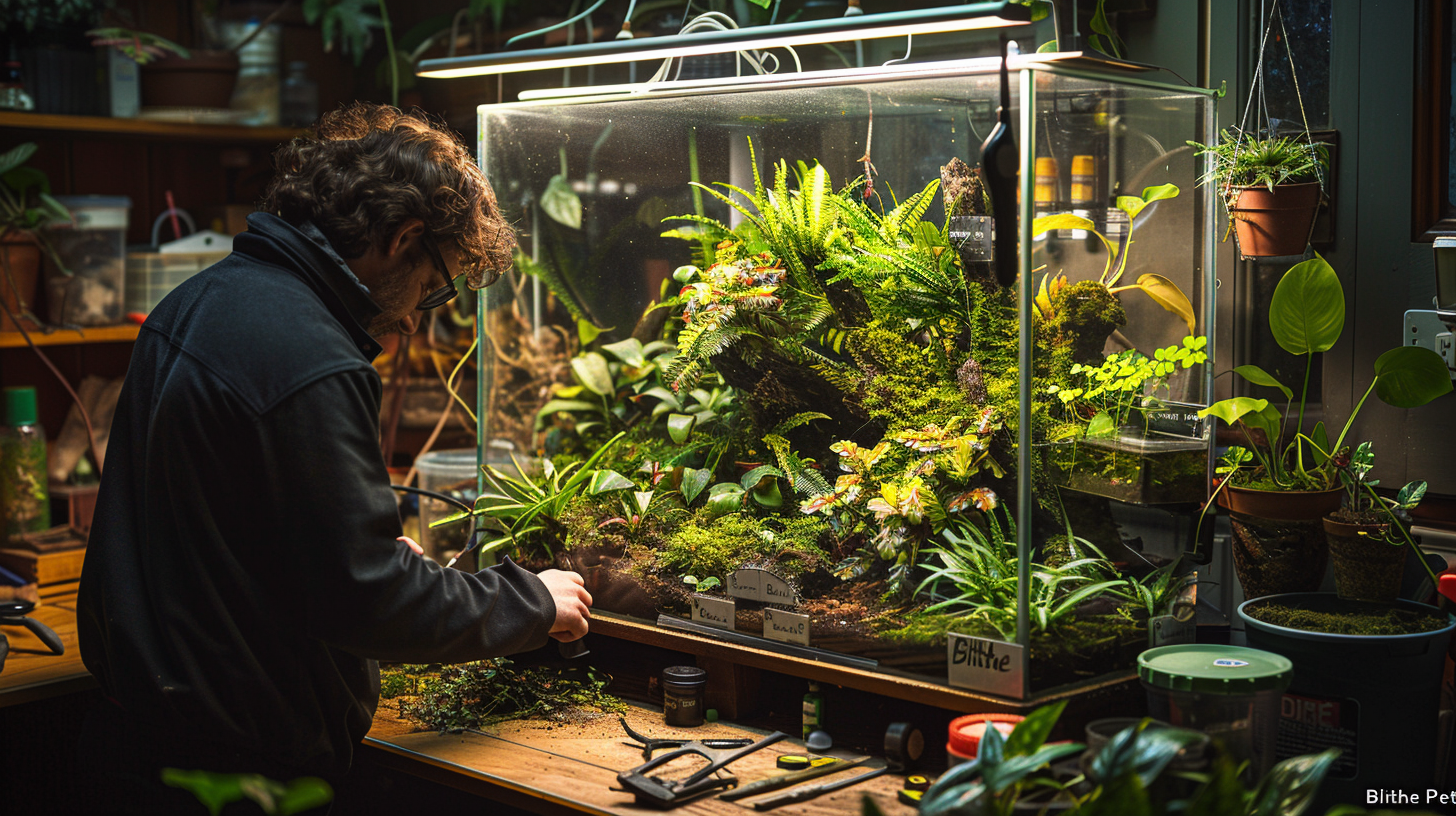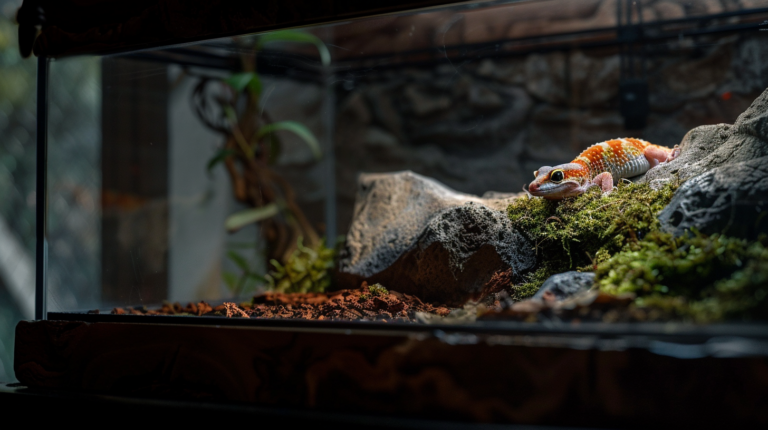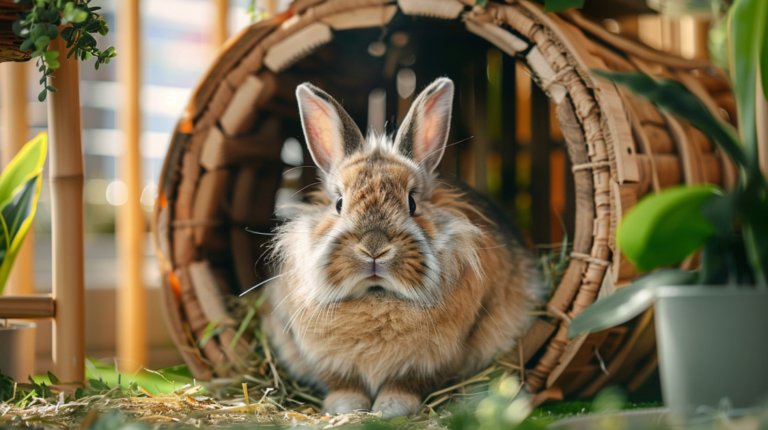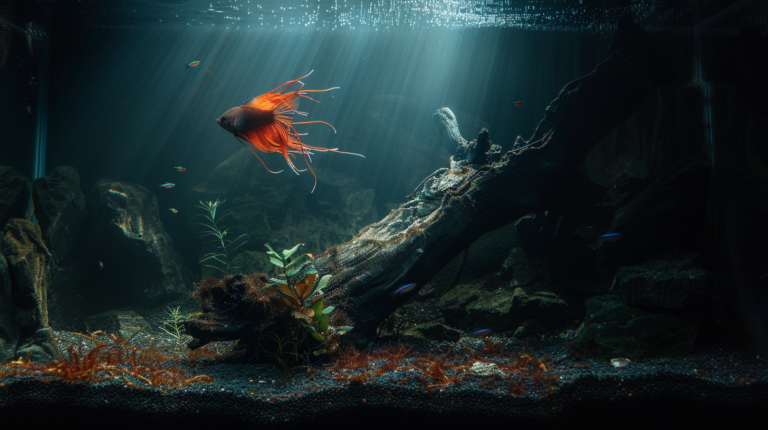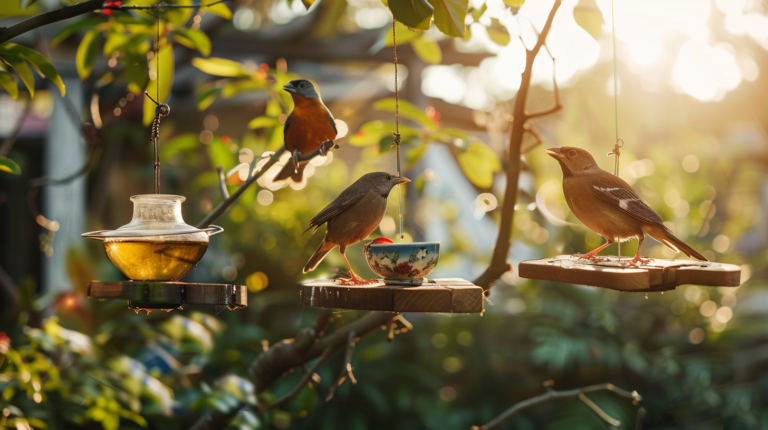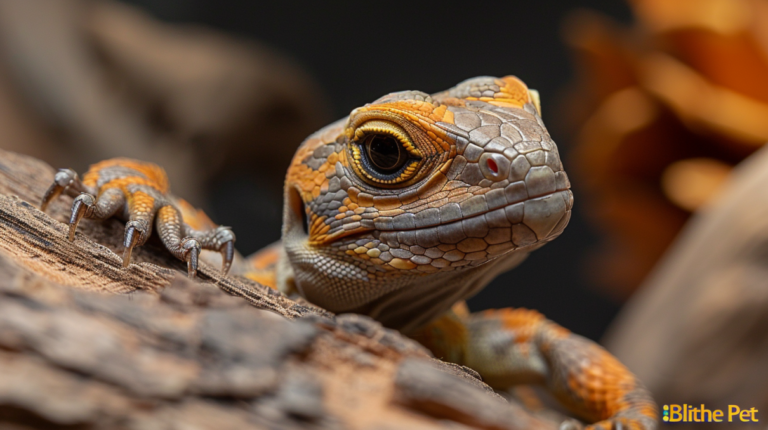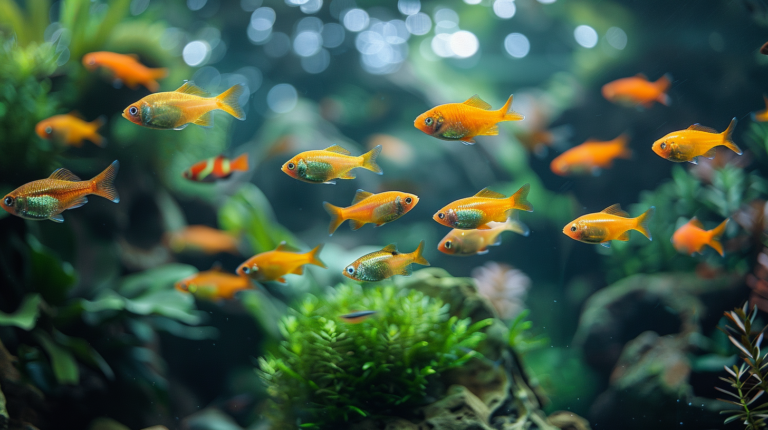Learn how to build the perfect Ackie Monitor Enclosure with our expert 8-step DIY guide. Essential setup tips for proper heating, substrate, and enrichment.
Table of Contents
Did you know that over 70% of reptile health issues stem from improper enclosure setups? When it comes to creating the perfect Ackie Monitor enclosure, getting the details right can mean the difference between a thriving pet and costly veterinary visits. These intelligent, active lizards from Australia require specific environmental conditions that closely mimic their natural habitat to maintain optimal health and behavior.
Building your own Ackie Monitor enclosure isn’t just cost-effective—it’s an opportunity to create a customized environment that meets your monitor’s exact needs. Whether you’re a first-time monitor keeper or looking to upgrade your current setup, this comprehensive guide will walk you through eight essential steps to create an enclosure that promotes natural behaviors, proper thermoregulation, and long-term health.
When I first set up my Ackie Monitor enclosure in my home in Colorado, I made several rookie mistakes that taught me valuable lessons. The most important lesson? Planning and research are everything. After consulting with reptile veterinarians and experienced keepers, I completely redesigned my approach, and the difference in my monitor’s activity level and feeding response was remarkable.
From selecting the right materials to establishing proper temperature gradients, we’ll cover everything you need to know to build a professional-quality Ackie Monitor enclosure that will serve your pet for years to come. Let’s dive into the essential steps that will transform your DIY project into a thriving ecosystem.
Step 1: Planning Your Ackie Monitor Enclosure Dimensions
The foundation of any successful Ackie Monitor enclosure begins with proper size planning. Adult Ackie Monitors require substantial space to exhibit natural behaviors, with minimum enclosure dimensions of 6 feet long, 3 feet wide, and 3 feet tall for a single adult. However, bigger is always better when it comes to monitor lizards.
Calculating Space Requirements
Your enclosure size should consider both horizontal and vertical space. Ackie Monitors are semi-arboreal, meaning they enjoy climbing and basking at different heights. A well-designed enclosure provides multiple levels of activity, with ground space for foraging and elevated areas for thermoregulation.
Professional Tip: Many keepers underestimate the importance of width in their enclosure design. Ackie Monitors are active hunters that need space to exhibit natural stalking and foraging behaviors. A narrow enclosure restricts these essential activities.
Room Integration Considerations
Before finalizing dimensions, consider how the enclosure will integrate into your living space. Factor in ventilation requirements, electrical access for heating and lighting equipment, and maintenance accessibility. Your enclosure should be positioned away from high-traffic areas but remain easily accessible for daily care routines.
The location should also provide stable ambient temperatures and protection from drafts. Sudden temperature fluctuations can stress your monitor and compromise their immune system, leading to health complications that require veterinary intervention.
Step 2: Selecting the Right Materials for Construction
Material selection directly impacts the longevity, safety, and functionality of your Ackie Monitor enclosure. The wrong materials can lead to costly repairs, safety hazards, or poor environmental control that affects your pet’s health.
Frame Construction Options
Melamine-faced particleboard remains the most popular choice for DIY monitor enclosures due to its moisture resistance, smooth surface, and cost-effectiveness. Avoid materials like untreated wood, which can harbor bacteria and absorb odors over time. For those seeking premium options, aluminum extrusion systems offer professional-grade construction with superior durability.
Safety Consideration: Ensure all materials are free from toxic treatments or finishes. Some pressure-treated lumber contains chemicals harmful to reptiles, while certain paints and sealers can off-gas toxic fumes in enclosed environments.
Glass and Ventilation Materials
Front panels typically use tempered glass or acrylic sheets for optimal viewing and easy cleaning. Acrylic offers better insulation properties but scratches more easily than glass. For ventilation, stainless steel mesh provides excellent airflow while preventing escapes and maintaining security.
Calculate ventilation area as approximately 10-15% of your total floor space, with intake vents near the bottom and exhaust vents near the top to promote natural convection. Proper ventilation prevents humidity buildup and ensures adequate air quality.
Step 3: Essential Heating and Lighting Systems
Temperature regulation forms the cornerstone of Ackie Monitor enclosure success. These reptiles require precise thermal gradients to properly digest food, maintain immune function, and exhibit natural behaviors. Inadequate heating remains one of the leading causes of monitor health problems.
Creating Temperature Zones
Your enclosure must provide a basking zone reaching 130-140°F (54-60°C), with ambient temperatures ranging from 85-95°F (29-35°C) during the day. Nighttime temperatures can drop to 75-80°F (24-27°C). This gradient allows your monitor to thermoregulate naturally by moving between zones.
Ceramic heat emitters work excellently for ambient heating, while halogen or metal halide bulbs provide intense basking heat. Avoid heat rocks or under-tank heaters as primary heat sources, as these can cause burns and don’t replicate natural heat distribution.
UVB Lighting Requirements
High-output UVB lighting is non-negotiable for Ackie Monitors. Use 10-12% UVB fluorescent tubes or mercury vapor bulbs that provide both heat and UVB. Replace UVB bulbs every 6-12 months, as output diminishes significantly over time, even when the bulb appears functional.
Position UVB sources 12-18 inches from basking areas, ensuring your monitor can access appropriate UV levels without glass or plastic barriers that filter beneficial wavelengths. Proper UVB exposure prevents metabolic bone disease and supports natural vitamin D3 synthesis.
Table 1 – Heating Equipment Comparison
| Equipment Type | Temperature Range | Coverage Area | Lifespan | Best Use Case |
|---|---|---|---|---|
| Halogen Flood Lamp | 120-150°F spot | 12-18 inch diameter | 2,000-4,000 hours | Primary basking heat |
| Ceramic Heat Emitter | 80-120°F ambient | 24-36 inch diameter | 10,000-15,000 hours | Nighttime/ambient heating |
| Metal Halide | 130-160°F spot | 18-24 inch diameter | 6,000-10,000 hours | Combined heat/UVB |
| Radiant Heat Panel | 85-110°F gentle | 24-48 inch panel | 20,000+ hours | Secondary heating |
| Mercury Vapor Bulb | 110-140°F moderate | 18-30 inch diameter | 6,000-8,000 hours | All-in-one solution |
Step 4: Substrate Selection and Preparation
Choosing the right substrate for your Ackie Monitor enclosure affects everything from maintenance routines to your pet’s natural behaviors. The ideal substrate supports burrowing instincts while maintaining appropriate humidity levels and allowing easy waste removal.
Natural Substrate Mixes
A blend of organic topsoil, sand, and coconut coir creates an excellent naturalistic substrate that holds burrows while providing drainage. Mix ratios of 40% topsoil, 40% sand, and 20% coconut coir provide optimal structure. This combination allows your monitor to dig complex tunnel systems that mimic their natural habitat.
Substrate depth should be 6-12 inches throughout most of the enclosure, with deeper areas reaching 18 inches in burrowing zones. Compact the substrate slightly during installation to prevent cave-ins while maintaining diggable consistency.
Maintenance and Safety Considerations
Avoid substrates like pine shavings, cedar, or calcium sand that can cause impaction or respiratory irritation. Newspaper or paper towels work for quarantine situations but don’t support natural behaviors long-term. Whatever substrate you choose must be spot-cleaned regularly and completely replaced every 3-4 months.
Health Warning: Monitor your lizard for signs of impaction if using loose substrates. Symptoms include loss of appetite, lethargy, and difficulty defecating. These signs require immediate veterinary attention.
Step 5: Ventilation and Air Quality Management
Proper airflow in your Ackie Monitor enclosure prevents stagnant air, controls humidity, and maintains air quality essential for respiratory health. Poor ventilation can lead to respiratory infections, one of the most common health issues in captive monitors.
Cross-Ventilation Design
Design your ventilation system with intake vents positioned low on one side and exhaust vents high on the opposite side. This configuration promotes natural convection currents that circulate fresh air throughout the enclosure. Screen vents should be fine enough to prevent escapes while allowing adequate airflow.
Calculate ventilation area based on enclosure volume and heating equipment. Higher-powered heating systems require increased ventilation to prevent overheating and maintain air quality. As a general rule, total vent area should equal 10-15% of your floor space.
Humidity Control Strategies
Ackie Monitors require moderate humidity levels between 60-70%. Ventilation systems must balance humidity retention with air circulation. Too much ventilation creates arid conditions, while insufficient airflow promotes bacterial growth and respiratory problems.
Install a reliable digital hygrometer to monitor humidity levels continuously. Adjust ventilation and water sources based on seasonal changes and heating requirements. During winter months, indoor heating systems often require additional humidity management.
Step 6: Creating Enrichment and Hiding Spaces
Environmental enrichment transforms a basic Ackie Monitor enclosure into a stimulating habitat that promotes natural behaviors and psychological well-being. Monitors are intelligent animals requiring mental stimulation to prevent stress and behavioral problems.
Multi-Level Design Elements
Incorporate sturdy branches, rock formations, and elevated platforms at various heights throughout the enclosure. These features serve dual purposes as basking sites and climbing opportunities. Ensure all structures can support your monitor’s full weight without shifting or collapsing.
Create multiple hiding spots using cork bark tubes, rock caves, or commercial reptile hides. Position hides in both warm and cool zones to allow thermoregulation while maintaining security. Your monitor should feel safe regardless of their chosen temperature zone.
Foraging and Activity Opportunities
Hide food items throughout the enclosure to encourage natural foraging behaviors. Puzzle feeders and treat-dispensing toys designed for reptiles provide mental stimulation during feeding times. Rotate enrichment items weekly to maintain novelty and interest.
Behavioral Insight: Monitors that lack adequate enrichment often develop stereotypical behaviors like glass surfing or aggressive tendencies. Enriched environments reduce stress and promote natural activity patterns.
Table 2 – Substrate Comparison Guide
| Substrate Type | Humidity Retention | Burrowing Support | Maintenance Level | Cost | Natural Appearance |
|---|---|---|---|---|---|
| Topsoil/Sand/Coir Mix | Excellent | Excellent | Moderate | Medium | Excellent |
| Cypress Mulch | Good | Poor | Low | Low | Good |
| Aspen Shavings | Fair | Good | Low | Low | Fair |
| Paper Towels | Poor | None | Very Low | Very Low | Poor |
| Tile/Vinyl | None | None | Very Low | Medium | Poor |
| Pure Sand | Fair | Excellent | High | Low | Good |
| Commercial Reptile Soil | Good | Good | Moderate | High | Good |
Step 7: Safety Features and Escape Prevention
Security measures in your Ackie Monitor enclosure protect both your pet and your household. Monitors are intelligent escape artists capable of exploiting the smallest weaknesses in enclosure design. A single escape can result in injury, loss, or property damage.
Locking Mechanisms and Door Design
Install secure locking mechanisms on all access points. Sliding doors with multiple lock points provide better security than hinged doors that can be pushed open. Consider the strength and intelligence of your monitor when selecting hardware—these animals can manipulate simple latches and squeeze through surprisingly small gaps.
Door seals should be tight enough to prevent escapes while allowing proper ventilation. Weather stripping or rubber gaskets work well for creating secure seals around door frames. Test all closures regularly to ensure they remain effective as the enclosure settles and hardware ages.
Electrical Safety Considerations
All electrical components must be properly protected from moisture and physical damage. Use GFCI outlets for any equipment near water sources, and secure all wiring away from areas where your monitor can access them. Heat lamps should be protected by wire guards to prevent burns and equipment damage.
Safety Protocol: Install backup temperature monitoring systems with alarms to alert you to equipment failures. A single heating element failure during cold weather can be fatal to your monitor within hours.
Step 8: Monitor-Specific Setup Requirements
The final step in creating your Ackie Monitor enclosure involves fine-tuning the environment to match your specific monitor’s needs and preferences. Individual animals may have particular requirements based on age, size, and behavioral patterns.
Age-Appropriate Modifications
Juvenile Ackie Monitors require more hiding spots and smaller food items than adults. Their enclosures can be proportionally smaller but must still maintain proper temperature gradients and UVB exposure. Plan for growth by designing expandable systems or preparing for enclosure upgrades.
Adult monitors need larger territory and more robust construction to handle their size and strength. Mature animals become more territorial and may require visual barriers to reduce stress from external activity.
Behavioral Considerations
Observe your monitor’s preferences for basking sites, hiding spots, and activity patterns. Some individuals prefer ground-level activities, while others spend considerable time climbing. Adjust your enclosure layout based on these observations to maximize your pet’s comfort and natural behaviors.
Monitor stress indicators include reduced appetite, excessive hiding, or aggressive behavior. Environmental modifications often resolve these issues without requiring veterinary intervention. However, persistent behavioral changes warrant professional evaluation.
Common Mistakes to Avoid in Ackie Monitor Enclosure Setup
Even experienced reptile keepers make errors when setting up monitor enclosures. Learning from these common mistakes can save time, money, and prevent health issues for your pet.
Undersized Enclosures
The most frequent error is creating enclosures that meet minimum size requirements without considering long-term needs. Monitors grow quickly and require progressively larger territories as they mature. Build your final enclosure size from the beginning rather than planning multiple upgrades.
Small enclosures restrict natural behaviors and can lead to stress-related health problems. The cost of building appropriately sized housing initially is always less than dealing with health issues or multiple construction projects.
Inadequate Temperature Monitoring
Relying on single thermometers or approximate temperature readings leads to dangerous thermal conditions. Invest in multiple digital thermometers with probe sensors placed at different heights and locations throughout the enclosure. Record temperatures daily to identify patterns and equipment issues.
Temperature Emergency: Monitor lizards can die from overheating within 30 minutes if trapped in temperatures exceeding 150°F (65°C). Always provide temperature refuges and monitor equipment function.
Poor Ventilation Design
Many DIY builders underestimate ventilation requirements, leading to stagnant air and bacterial growth. Inadequate airflow also reduces heating efficiency and creates humidity problems. Design your ventilation system before beginning construction rather than trying to modify it later.
Cross-ventilation with intake and exhaust points creates better air circulation than single-point ventilation systems. Natural convection reduces the need for mechanical fans while maintaining quiet operation.
Expert Tips for Long-Term Success
Maintaining your Ackie Monitor enclosure requires ongoing attention and periodic updates. These expert tips help ensure your setup continues meeting your pet’s needs throughout their 15-20 year lifespan.
Seasonal Adjustments
Modify heating and lighting schedules to reflect natural seasonal variations. Gradual changes in photoperiod and temperature help maintain natural circadian rhythms and may improve breeding behaviors in mature animals. Winter cooling periods of 2-3 weeks can benefit adult monitors’ overall health.
Humidity requirements may fluctuate seasonally based on your local climate and indoor heating systems. Monitor these changes and adjust ventilation or water sources accordingly.
Preventive Maintenance Schedule
Establish regular maintenance routines including weekly spot cleaning, monthly deep cleaning, and quarterly equipment inspections. Replace UVB bulbs according to manufacturer recommendations, typically every 6-12 months. Clean and inspect all electrical connections monthly for signs of corrosion or damage.
Maintenance Checklist:
- Daily: Temperature and humidity checks, fresh water, spot cleaning
- Weekly: Complete substrate spot cleaning, equipment function check
- Monthly: Deep clean all surfaces, inspect locks and seals
- Quarterly: UVB bulb replacement, complete equipment review
Upgrade Planning
Plan for future improvements and equipment upgrades from the initial design phase. Leave space for additional heating elements, larger water features, or expanded climbing structures. Modular designs allow for easier modifications as your understanding of your monitor’s preferences grows.
Economic Tip: Quality equipment purchases save money long-term through improved reliability and performance. Budget for professional-grade components that will last your monitor’s entire lifetime.
For more expert pet care tips and product recommendations, visit BlithePet.com your trusted source for pet wellness.
Warning Signs Every Ackie Monitor Owner Should Know
Recognizing early warning signs of health or environmental problems can prevent serious complications requiring emergency veterinary care. Monitor your pet’s behavior and physical condition daily for these critical indicators.
Respiratory Distress Symptoms
Mouth breathing, wheezing sounds, or excessive mucus around the nose and mouth indicate respiratory infections. These symptoms often result from poor air quality, incorrect humidity levels, or inadequate temperatures. Respiratory infections can become life-threatening within days without proper treatment.
Remove your monitor to a clean, properly heated quarantine setup immediately if respiratory symptoms appear. Schedule emergency veterinary care with a reptile-experienced veterinarian the same day symptoms are noticed.
Digestive and Nutritional Issues
Loss of appetite lasting more than 48 hours, regurgitation, or absence of defecation for over a week signal serious problems. These symptoms may indicate parasitic infections, impaction, or inadequate environmental conditions affecting digestion.
Emergency Signs: Lethargy combined with bloated appearance or inability to defecate requires immediate veterinary attention. These symptoms suggest impaction, which can be fatal without surgical intervention.
Thermal Regulation Problems
Constant basking or inability to warm up indicates heating system failures or illness. Monitors should move freely between temperature zones throughout the day. Animals stuck in one area or showing temperature-seeking behaviors need immediate environmental assessment.
Overheating symptoms include open-mouth breathing, excessive hiding, or attempts to dig into substrate. Check all heating equipment immediately and provide cooling options if overheating is suspected.
Table 3 – Monthly Maintenance Schedule
| Week | Primary Tasks | Equipment Checks | Health Monitoring | Environmental |
|---|---|---|---|---|
| Week 1 | Deep substrate cleaning, water change | Heat lamp function, thermostat accuracy | Weight check, appetite assessment | Temperature gradient verification |
| Week 2 | Complete surface disinfection | UVB output testing, timer function | Skin condition inspection, shedding signs | Humidity level adjustment |
| Week 3 | Enrichment rotation, hide cleaning | Ventilation system check, fan operation | Behavior pattern observation | Photoperiod schedule review |
| Week 4 | Full equipment inspection | Electrical connections, GFCI testing | Waste production monitoring | Seasonal adjustment planning |
When to Consult a Veterinarian
Understanding when your Ackie Monitor enclosure setup requires professional evaluation protects your pet’s health and your investment. Certain situations warrant immediate veterinary consultation regardless of your experience level.
Emergency Situations
Any combination of lethargy, loss of appetite, and abnormal posture requires emergency veterinary care within 24 hours. Monitors can deteriorate rapidly when ill, and early intervention dramatically improves treatment outcomes. Don’t attempt home remedies for serious symptoms.
Trauma from falls, burns, or equipment failures needs immediate professional assessment even if injuries appear minor. Internal damage or infection can develop days after the initial incident, making prompt evaluation critical.
Routine Health Assessments
Schedule annual health examinations with a reptile-experienced veterinarian even for apparently healthy animals. These visits establish baseline health parameters and identify developing problems before they become serious. Fecal parasite testing should be performed annually or when symptoms suggest digestive issues.
Professional Guidance: Veterinary consultation during initial setup can prevent costly mistakes and health problems. Many reptile veterinarians offer enclosure design consultations that save money compared to correcting problems later.
Debunking Common Ackie Monitor Myths
Misinformation about monitor care circulates widely in online forums and outdated care guides. These persistent myths can lead to serious health problems and inadequate enclosure designs.
Myth: Monitors Don’t Need UVB Lighting
This dangerous misconception stems from the assumption that dietary vitamin D3 supplementation replaces natural UVB synthesis. Recent research clearly demonstrates that monitors require UVB exposure for optimal bone development, immune function, and natural behaviors. Monitors without UVB access develop metabolic bone disease despite vitamin supplementation.
Proper UVB lighting is non-negotiable for long-term health. No amount of dietary supplementation can replace the complex physiological processes triggered by natural UVB exposure.
Myth: Larger Enclosures Stress Monitors
Some sources incorrectly claim that large spaces overwhelm monitors or make them difficult to feed. In reality, appropriately designed large enclosures with adequate hiding spots and thermal zones reduce stress and promote natural behaviors. Wild monitors have territories measured in acres, not square feet.
The key is providing sufficient hiding options and resource distribution throughout the available space. A well-designed large enclosure always outperforms cramped quarters for monitor welfare.
Myth: Heat Rocks Are Safe Heating Sources
Despite persistent availability in pet stores, heat rocks cause severe burns and don’t provide appropriate thermal gradients. These devices create dangerous hot spots that can cause third-degree burns before monitors can react. Natural basking behavior involves heat from above, not below.
Safety Warning: Heat rock burns often go unnoticed until extensive tissue damage occurs. Use only overhead heating sources that mimic natural sunlight for your monitor’s safety.
FAQ Section :
Conclusion
Creating the perfect Ackie Monitor enclosure requires careful planning, quality materials, and attention to your pet’s specific needs. These eight essential steps provide the foundation for a habitat that supports natural behaviors, maintains optimal health, and offers years of reliability. Remember that proper setup prevents most health issues and creates a rewarding experience for both you and your monitor.
The investment in quality enclosure construction pays dividends through reduced veterinary costs, improved pet health, and the satisfaction of providing excellent care. Your monitor’s active, confident behavior will reflect the quality of their environment and your dedication to their welfare.
Success with monitor keeping comes from understanding that these intelligent animals require more than basic survival needs—they thrive in enriched environments that challenge their minds and support their natural instincts. The enclosure you build today will serve as your pet’s entire world for the next two decades.
Have questions about your specific Ackie Monitor enclosure setup? Remember that experienced reptile veterinarians and established monitor communities provide valuable guidance for complex situations. Every monitor is unique, and fine-tuning your approach based on your pet’s individual responses leads to the best outcomes.

